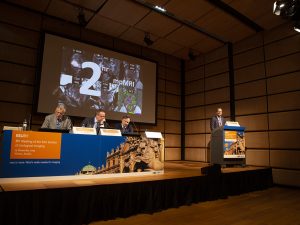The meeting dedicated to the role and impact of new imaging technologies, the 7th EAU Section of Urological Imaging (ESUI18) commenced today with the overarching theme “Getting it right: Indications for modern urological imaging”. ESUI Chairman Prof. Georg Salomon (DE) welcomed enthusiastic participants in Amsterdam, The Netherlands.
The first ESUI18 session “From finger guided to imaging targeted biopsy”, which was moderated by Prof. Salomon, Prof. Dr. Jelle Barentsz (NL) and Prof. Dr. Tillmann Loch (DE), featured presentations of Prof. Dr. Florian Wagenlehner (DE) and Mr. David Eldred-Evans (GB).
In his lecture “Transrectal biopsies and sepsis. Antibiotic prophylaxis: Which, when, how long?”, Prof. Wagenlehner enumerated strategies to minimise infectious complications such as indication for prostate biopsy consisting of control elevated prostate-specific antigen (PSA) and prostate MRI. He added that with regard to selecting for risk factors (specifically, risk of fluoroquinolone-resistant pathogens), “If you want to perform transrectal prostate biopsies, you should take into account the patients’ travel history to countries with high prevalence. Targeted swabbing is good and to also do it for susceptibility testing.” Additionally, he stated that combining antibiotics is “not the right way forward.”
Prof. Wagenlehner mentioned some of the general risk factors for infectious complications after biopsy which included high comorbidity, badly controlled diabetes mellitus and enlarged prostate. He also emphasised that antibiotic resistance is the most important risk factor.
Transperineal biopsy
“Transperineal biopsy approach eliminates the problems of sepsis. It is becoming more feasible and deliverable as a universal approach; and it can be considered as an office-based technique because of the emergence of new developments, equipment and technologies,” said Mr. Eldred-Evans in his lecture “Can transperineal biopsies solve the problem?”.
“We’ve been doing transrectal biopsies for nearly 30 years and we are now at another stage of evolution in the prostate biopsy story,” stated Mr. Eldred-Evans. “It is clear that the direction is towards image-guidance. However, we must also acknowledge that this transition will take time. We need to build MRI experience and capacity and as we do that, it presents us with an opportunity of not just rethinking the method of guiding the biopsy, but the whole biopsy approach.”
Transperineal biopsy has the advantage of improving the sampling of the anterior and apical regions of the prostate. “And because the needles don’t transverse the rectal mucosa, the risk of sepsis is virtually eliminated. There aren’t too many randomised control trials in this area, not as many as the TRUS biopsy but when you look at the large cohort series reporting on transperineal biopsy complications, you can see the benefits.”
Over 2,000 patients were enrolled and the high rate of haematuria (73.4% prevalence) illustrated good-quality of the procured data via a questionnaire. The rate for fever is very low (1.7% prevalence) and no cases of hospital admissions due to sepsis [Namekawa et al 2015].
Mr. Eldred-Evans also cited the conclusion of another study [Guo et al 2005] that both TPBx (Transperineal biopsy) and TRPx (TRUS biopsy) are effective to detect PCa. The major complication rate for TRBx is higher, whereas TBPx procedure is more complex and painful. He said, “Fortunately, this is no longer the case for transperineal biopsy due to well-established local anaesthetic protocols which allow transperineal biopsies to be performed in an office setting.”
Mr. Eldred-Evans mentioned that four centres in London have stopped performing TRUS biopsy and moved on to the transperineal biopsy approach instead.
To know more, access the ESUI18 Resource Centre.





